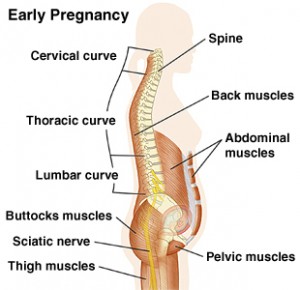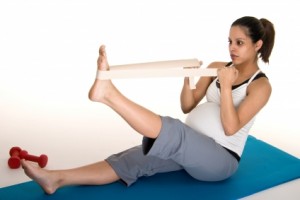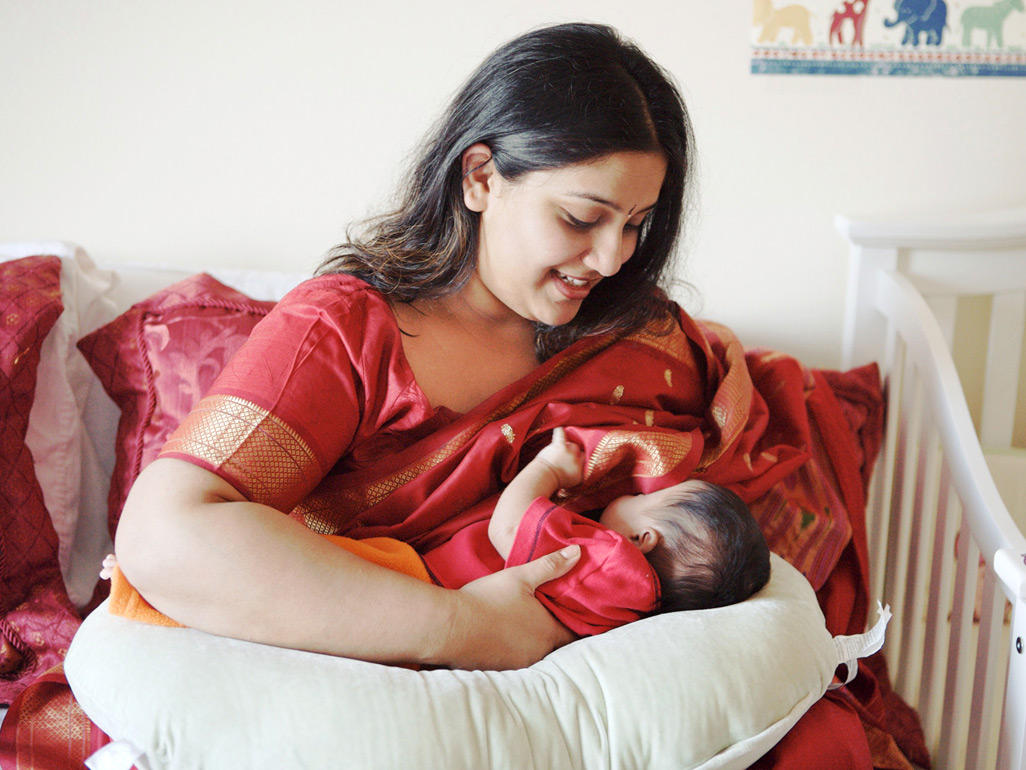This article is excerpted from the handbook 'Active Spine', which will be released soon by the Publishing House: www.Landie.pl.
Theory
Pregnancy is a new challenge for woman’s body. Loads of biomechanical changes occur: a growing midriff shifts the centre of gravity and greater weight causes stress on joints and intervertebral discs. These are physiological changes and a healthy active back handles them well. If you did not have back problems before pregnancy, it is likely you would avoid them while pregnant, provided that your spine is properly “serviced” (taken care of).

Image Courtesy: http://www.ne-backpain.co.uk
If your physical activity before pregnancy was limited to driving and sitting behind your office desk, then you should sign up for training carried out by a specialist, to prepare for the birth and the last trimester of pregnancy. Exercises should be properly tailored to your capabilities. The role of well-functioning muscles turns out to be very important in later pregnancy, when the body produces natural hormones that relax and loosen ligaments. The easiest and most effective exercise proves to be walking. Alternate loading of the pelvis while walking acts as a massage on your muscles and causes the natural alignment of joints. The fluctuating pressure nourishes cartilage and intervertebral discs. For maximum effectiveness you should walk for the minimal distance of at least 3 kilometres of continuous marching. If you use Nordic walking sticks, your knees will be relieved and upper body – activated. This simple but effective exercise is highly recommended, which should be performed at least 3 times a week. Exercises using Swiss balls, yoga and swimming pool have also a very positive influence on your body.
Keeping a proper body posture can prevent ailment. Growing breasts cause impulsive slouching – you have to control it because such a position increases the risk of thoracic spine pain and most likely headaches. Remember to stand up straight! You may exercise muscles of shoulder blades using an elastic tape.
Do not overload! You have to control your body mass, you will certainly gain weight, but make sure this

Image Courtesy:http://www.steadyhealth.com
When sitting, avoid armchair position, when your spine is curved as a letter C. Do not cross your legs, relaxation of the pelvic joints may cause their blockage and unpleasant pain.
Greater weight means greater strain on feet. Increasing diagonal flat foot during pregnancy may lead to hallux valgus in the future. If you have a tendency to diagonal flat feet you should get tailor-made orthopaedic insoles for the time of your pregnancy.
High heels completely change walking biomechanics, turning you into a “toe-walker”. This additionally overloads the lumbar spine. Do not exaggerate with wearing such shoes.
Examples of exercises
Exercises during pregnancy should always be approved by your doctor. Exercises recommended below may be performed all the way through pregnancy, as long as there are no medical contraindications to physical activity.
Except for exercise No 9, they should be performed according to the following rules:
– after each exercise the position should be endured for 20 seconds
– back to the initial position
– 5 seconds break
– number of repetitions – it is recommended that you exercise until you become tired or unable to maintain the correct position.
1, 2, 3 – stabilization and sensorimotor exercises using sensorimotor pillow or Togu® (supporting pillow).
Active sitting
1. Alternate straightening of lower limbs. It is important to keep your back straight!
2. Lifting hips to the straight line of the body
3. Alternate lifting limbs. It is important to keep your back straight!
3a Alternate lifting upper limbs 3b Alternate lifting lower limbs
3c Alternate lifting upper and lower limbs together
4, 5 – stabilization and sensorimotor exercises using stool, sensorimotor pillow and ball
4. Sitting on a sensorimotor pillow on a stool.It is important to keep your back straight!
4a Alternate straightening of knees 4b Lifting both legs up.
5. Bending forward with the ball. It is important to keep your back straight!
5a 5b
6, 7, 8, 9 – stabilization exercises using a big rehabilitation ball.
6. Lifting hips to the straight line of the body.
6a 6b Pulling the ball towards you with your hips lifted
7. Bending forward. This movement is only performed within range and movement of knee joints. The range of movement depends on the ability of keeping the correct position (straight back).
7a 7b
8. Lifting the big ball up.
8a 8b
9. Moving from sitting position to lying on your back. We perform 3 sets of 20 repetitions with a 2 minute break after each set.
9a 9b
9c

Dariusz Straszewski, MA in Physiotherapy, Physiotherapy Department Manager at the orthopaedics and sports medicine clinic Carolina Medical Center in Warsaw, Poland; experienced lecturer and teacher of practical therapy techniques within orthopaedic rehabilitation and sports medicine; author of articles and guidebooks in this area; frequent guest of radio and TV programs; as a physiotherapist he works with leading Polish athletes and Olympians.
Inspiration and cooperation for this and other projects has been with Daria Mejnartowicz (2012 Fortune/US State Department Global Women’s Mentoring Partnership Alumna) who along with Darek cooperate with Polish Professional Women Network and Vital Voices Poland.


























Hi there, just became aware of your blog through Google, and found that
it is truly informative. I’m going to watch out for brussels.
I’ll be grateful if you continue this in future.
Many people will be benefited from your writing. Cheers!
Thanks for sharing your thoughts about Click here.
Regards
” This is the “consuming fire” of God mentioned in the Holy Scriptures. If I had those two in my life, I settled much faster and I felt happy. Do you want to add this to your spiritual tool box. Let him call for the elders of the church, and let them pray over him, anointing him with oil in the name of The Lord; and the prayer of faith will save the sick man, and The Lord will raise him up; and if he has committed sins, he will be forgiven. It took a bit of practice until I finally felt and experienced the difference between looking at life through my mind and looking at life through my heart.
Wow, wonderful blog layout! How long have you been blogging for? you make blogging look easy. The overall look of your site is excellent, let alone the content!
I worked with Doctor Odunga to get my ex husband back to me and also get pregnant with twins girls after 12 years of marriage.
When I came online last year, I met a testimony about Doctor ODUNGA how he has been helping people with marriage issues and I decided to contact him. We spoke on email at (odungaspelltemple@gmail.com) and later he gave me his Whats App number which is +2348167159012. He assured me he would help me get my ex husband back after 3 years of no contact. My husband left me because I was unable to give him a child for 9 years after our marriage. There was no contact between us anymore and I didn’t know how to get to him. Doctor Odunga is the best spell caster I must say. My husband called me after 2 days of contacting Dr. Odunga. The third day, I received a med treatment for fertility from this man, I became fertile. I and my husband reconnected that very week, had sex and I was pregnant. Presently I am happy to say I am the mother of twins girls and this is ALL THANKS TO DOCTOR ODUNGA. I came online to say this If you need help, I believe you are saved with this man. Contact his email at (odungaspelltemple@gmail.com) and you too will give a testimony too to help others
Interesting article and I would like to say thanks to you for providing this wonderful post. Really useful and keep it up the good work
Hello everyone, I am Stephanie Sally. I am from Britain. I want to write this testimony to tell others and thank Prophet Odunga for what he has done for me. I am married for 12 years now and i have given birth to 5 children but they all died within days and i was called all sort of names by my mother-in-law and this has made my marriage life very hectic and a burden of sorrow. I contacted Priest Odunga for help and i will say that he is a very strong spell caster and he indeed help me solve my problem. I saw his email in a testimony and i contacted him, little did i know it would be the end of all my problems. My husband even loved me more and bought me expensive things. One afternoon, i felt my womb moving and after 9 months i gave birth to a baby boy and now my boy is growing up. Ever since i contacted Prophet Odunga, my story has been different. Please, contact him at odungaspelltemple@ gmail. com or WhatsApp/Call +2348167159012 to help you